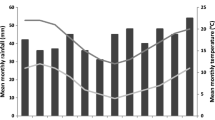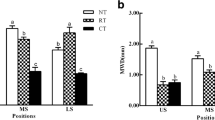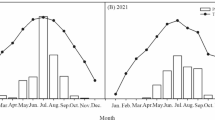Abstract
Soil plays a pivotal role in enhancing global water and food security. Irrigation water constitutes more than 70% of the global water demand. The anticipated demographic increase and changing climate will impose more pressures on the global water and food systems. Therefore, and to achieve the target of “more crop per drop per area”, water management plans must be based on more accurate quantitative and dynamic approaches. It is increasingly obvious that the unique aggregates structure of the soil medium regulates water and nutrient circulations, and consequently defines soil and water health, productivity, and water use efficiency. However, the soil aggregates structure is not currently well considered in the quantification of soil–water holding properties. The authors applied a thermodynamic and soil structure-based approach to quantify soil–water holding properties. Specifically, the paper aims at providing a methodology, based on the pedostructure concept, to quantify field capacity (FC), permanent wilting point (PWP), and plant available water (AW). Pedostructure is a representative aggregates unit of a soil horizon that describes the structural organization of the soil medium. Four types of soil were analyzed considering various soil texture and aggregates structure: loamy fine sand, silt loam, clay loam, and silty clay loam. The calculated values for FC and PWP, based on the proposed pedostructure method, were compared with the recommended values by the standard FAO method and soil suction method. Results showed good agreement between the calculated values of the two methods. The proposed pedostructure method introduces a shift in quantifying the plant available water from a texture-based estimation to a soil aggregates structure-based calculation. Such a shift will enable capturing the changes in soil aggregates structure due to agro-environmental practices and the associated impact of these changes on soil–water holding properties.



Similar content being viewed by others
References
Adekalu KO, Fapohunda HO (2007) Comparisons of two soil water flow models under variable irrigation. Irrig Sci 25:375–385
Allen RG, Pereira LS, Raes D, Smith M (1998) Crop evapotranspiration: guidelines for computing crop requirements. Irrigation and Drainage Paper No. 56, FAO, (56), p 300
Aschonitis VG, Antonopoulos VZ, Lekakis EH, Kotsopoulos SA, Karamouzis DN (2013) Estimation of field capacity for aggregated soils using changes of the water retention curve under the effects of compaction. Eur J Soil Sci 64:688–698
Assi AT, Accola J, Hovhannissian G, Mohtar RH, Braudeau E (2014) Physics of soil medium organization, Part 2: pedostructure characterization through measurement and modeling the soil moisture characteristic curves. Front Environ Sci 2:5
Bellier G, Braudeau E (2013) Device for measurement coupled with water parameters of soil. Geneva: WO2013/004927A1, World Intellectual Property Organization, European Patent Office
Braudeau E, Mohtar RH (2009) Modeling the soil system: bridging the gap between pedology and soil–water physics. Glob Planet Change J 67:51–61
Braudeau E, Frangi JP, Mothar RH (2004) Characterizing non-rigid dual porosity structured soil medium using its shrinkage curve. Soil Sci Soc Am J 68:359–370
Braudeau E, Sene M, Mohtar RH (2005) Hydrostructural characteristics of two African tropical soils. Eur J Soil Sci 56:375–388. https://doi.org/10.1111/j.1365-2389.2004.00679.x
Braudeau E, Assi AT, Boukcim H, Mohtar RH (2014a) Physics of soil medium organization, Part 1: thermodynamic formulation of the pedostructure water retention and shrinkage curves. Front Environ Sci 2:4
Braudeau E, Hovhannissian G, Assi AT, Mohtar RH (2014b) Soil water thermodynamic to unify water retention curve by pressure plates and tensiometer. Front Earth Sci 2:30. https://doi.org/10.3389/feart.2014.00030
Braudeau E, Assi AT, Mohtar RH (2016) Hydrostructural pedology. Wiley-ISTE, p 186. ISBN: 978-1-84821-994
Brewer R (1964) Fabric and mineral analysis of soils. Wiley, New York, p 482
Cassel DK, Nielsen DR (1986) Field capacity and available water capacity. In: Klute A (ed) Methods of soil analysis: Part 1. Physical and mineralogical methods, Agron. Monogr. Ser. 9. American Society of Agronomy and Soil Science Society of America, Madison, Wis, pp 901–926
Coughlan KJ, Mc Garry D, Loch RJ, Bridge B, Smith D (1991) The measurement of soil structure. Aust J Soil Res 29:869–889
Haines WB (1923) The volume changes associated with variations of water content in soil. J Agric Sci Camb 13:296–311
Linsley RK, Franzini JB (1972) Water resources engineering. McGraw-Hili Inc., New York
Meyer PD, Gee G (1999) Flux-based estimation of field capacity. J Geotech Geoenviron Eng 125(7):595–599
Miller RD, McMurdie JL (1953) Field capacity in laboratory columns. Soil Sci Soc Am J 17:185–190
Nachabe MH (1998) Refining the definition of field capacity in the literature. J Irrig Drain Eng 124:230–232
Nemes A, Pachepsky YA, Timlin DJ (2011) Toward improving global estimates of field soil water capacity. Soil Sci Soc Am J 75(3):807–812
Pachepsky YA, Rawls WJ (eds) (2004) Development of pedotransfer functions in soil hydrology. Elsevier, Amsterdam
Ratliff LF, Ritchie JT, Cassel DK (1983) Field-measured limits of soil water availability as related to laboratory-measured properties. Soil Sci Soc Am J 47(4):770–775
Rawls WJ, Brakensiek DL, Saxton KE (1982) Estimation of soil water properties. Trans ASAE 25:1316–1328
Richards LA, Weaver LR (1944) Moisture retention by some irrigated soils as related to soil moisture tension. J Agric Res 69:215–235
Romano N, Santini A (2002) Field. In: Dane JH, Topp GC (eds) Methods of soil analysis. Part 4, physical methods, Soil Sci. Soc. Am. Book Ser., vol 5. Soil Sci. Soc. of Am., Madison, Wis, pp 721–738
Safadoust A, Feizee P, Mahboubi AA, Gharabaghi G, Mosaddeghi CMR, Ahrens B (2014) Least limiting water range as affected by soil texture and cropping system. Agric Water Manag 136:34–41
Saxton H, Rawls W (2006) Soil water characteristic estimates by texture and organic matter for hydrologic solutions. Soil Sci Soc Am J 70:1569–1578
Scheibert C, Stietiya M, Sommer J, Schramm H, Memah M (2005) The Atlas of soils for the State of Qatar, soil classification and land use specification project for the State of Qatar, Ministry of Municipal Affairs and Agriculture, General Directorate of Agricultural Research and Development, Department of Agricultural and Water Research. Ministry of Municipal Affairs and Agriculture, Doha
Twarakavi NKC, Sakai M, Simunek J (2009) An objective analysis of the dynamic nature of field capacity. Water Resour Res 45:W10410
Veihmeyer FJ, Hendrickson AH (1931) The moisture equivalent as a measure of the field capacity of soils. Soil Sci 32:181–194
Zacharias S, Bohne K (2008) Attempt of a flux-based evaluation of field capacity. J Plant Nutr Soil Sci 171(3):399–408
Zotarelli L, Dukes MD, Scholberg JMS, Munoz-Carpena R, Icerman J (2009) Tomato nitrogen accumulation and fertilizer use efficiency on a sandy soil, as affected by nitrogen rate and irrigation scheduling. Agric Water Manag 96:1247–1258
Acknowledgements
The authors wish to acknowledge TAMUS WEF Nexus Initiative and the WEF Nexus research group for their support of this work. The authors would like to express a special acknowledgement to Mary Schweitzer and Sonja Loy from the WEF nexus team at Texas A&M University.
Author information
Authors and Affiliations
Corresponding author
Ethics declarations
Conflict of interest
The authors declare that the research was conducted in the absence of any commercial or financial relationships that could be construed as a potential conflict of interest.
Additional information
Communicated by A. Furman.
Publisher's Note
Springer Nature remains neutral with regard to jurisdictional claims in published maps and institutional affiliations.
Rights and permissions
About this article
Cite this article
Assi, A.T., Blake, J., Mohtar, R.H. et al. Soil aggregates structure-based approach for quantifying the field capacity, permanent wilting point and available water capacity. Irrig Sci 37, 511–522 (2019). https://doi.org/10.1007/s00271-019-00630-w
Received:
Accepted:
Published:
Issue Date:
DOI: https://doi.org/10.1007/s00271-019-00630-w




